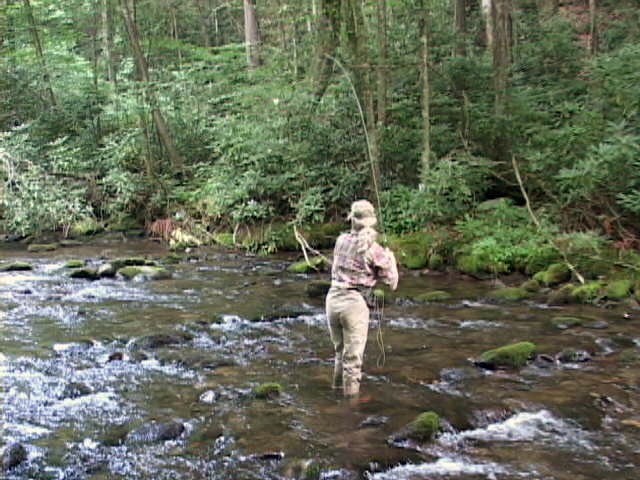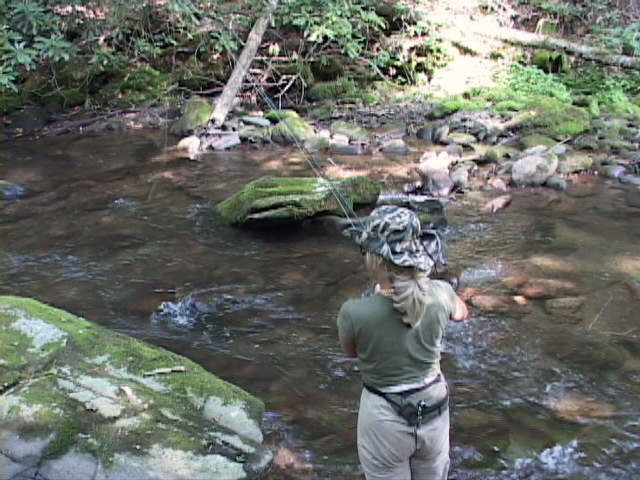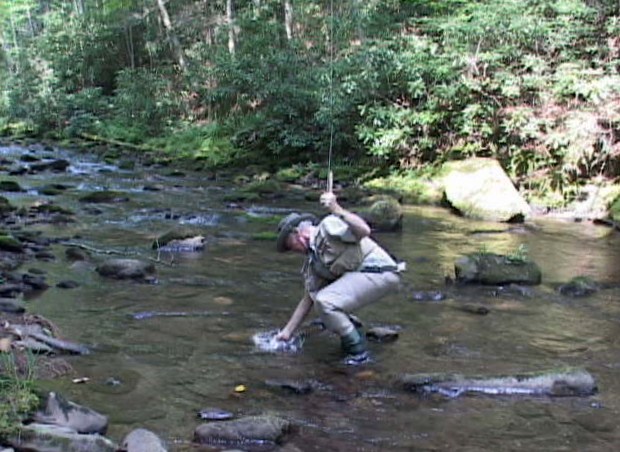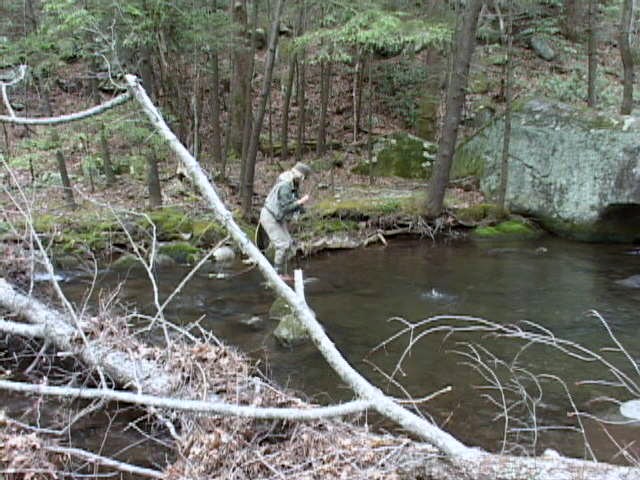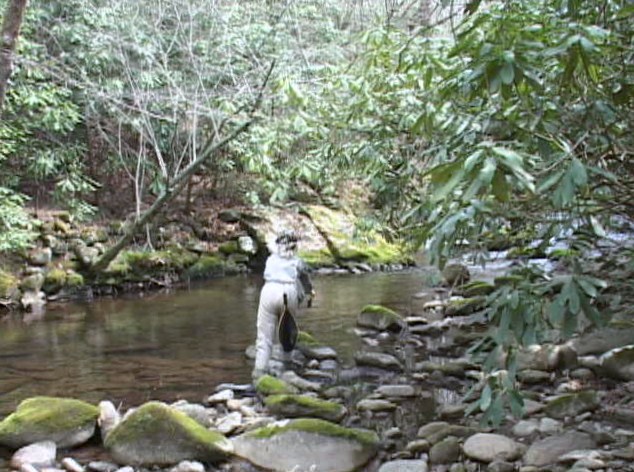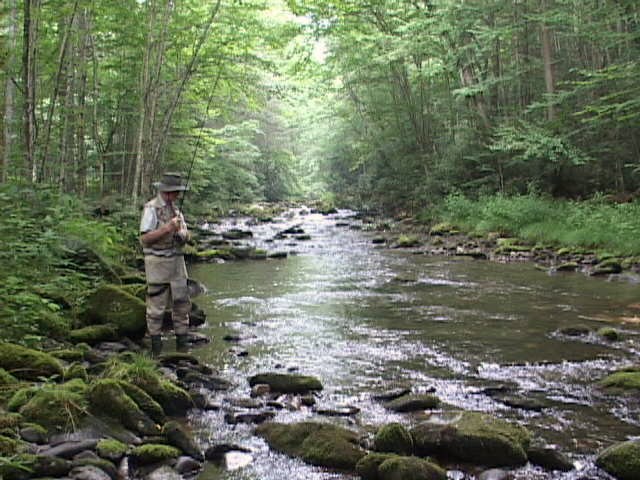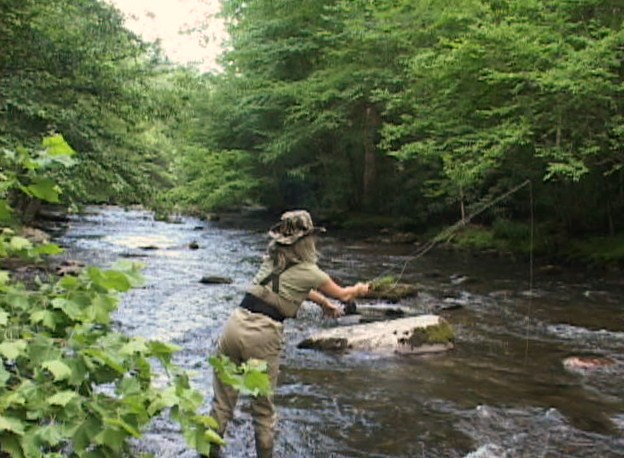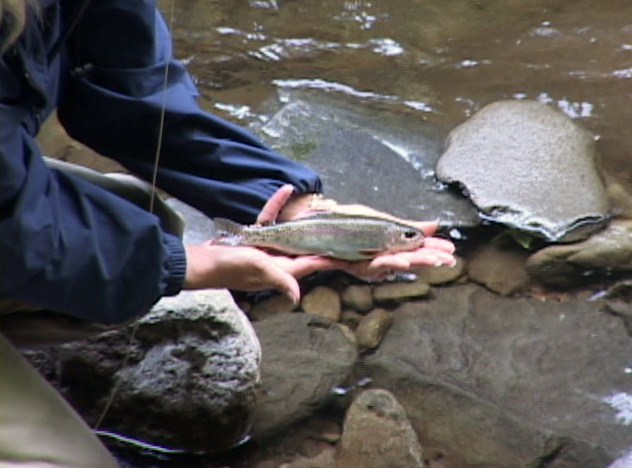
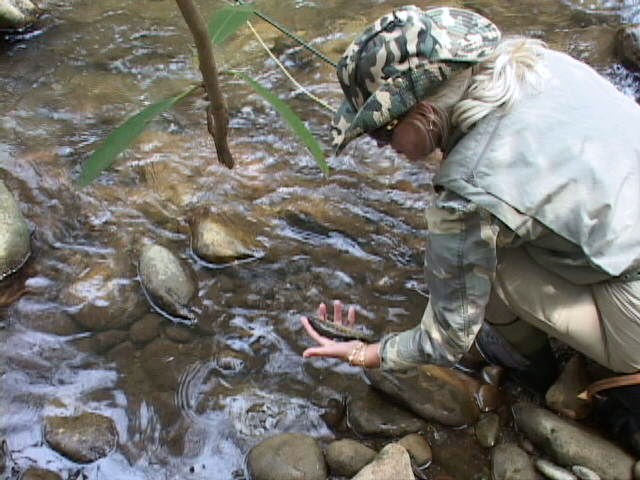
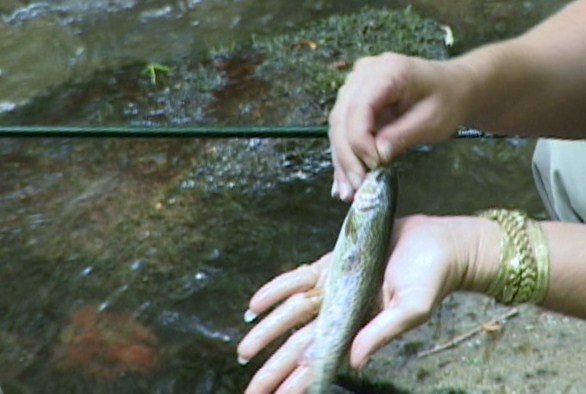
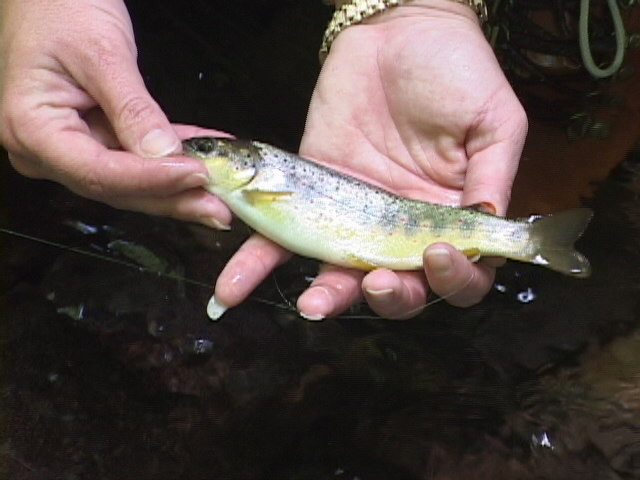
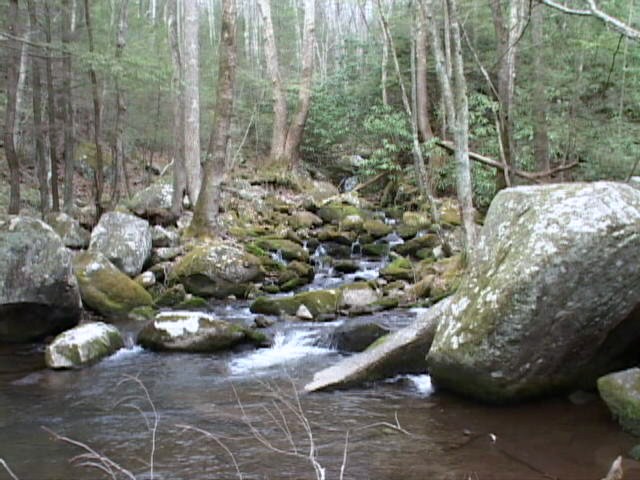
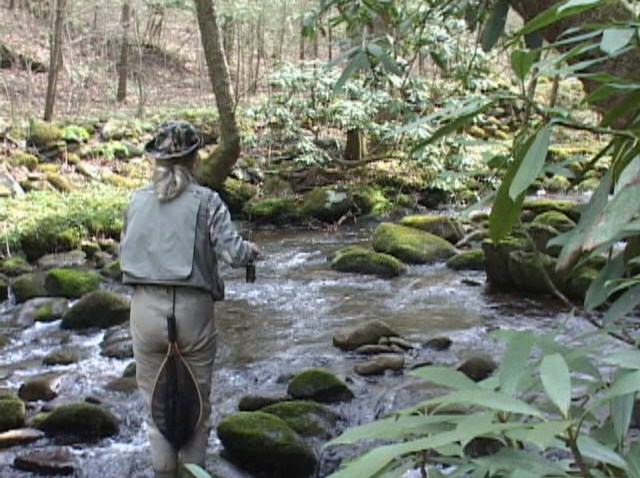
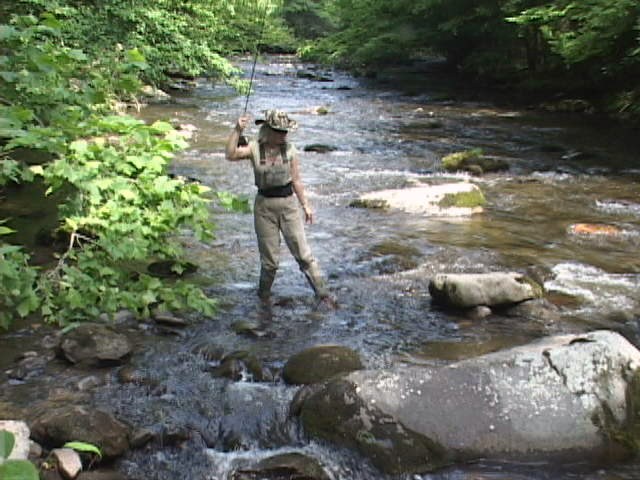
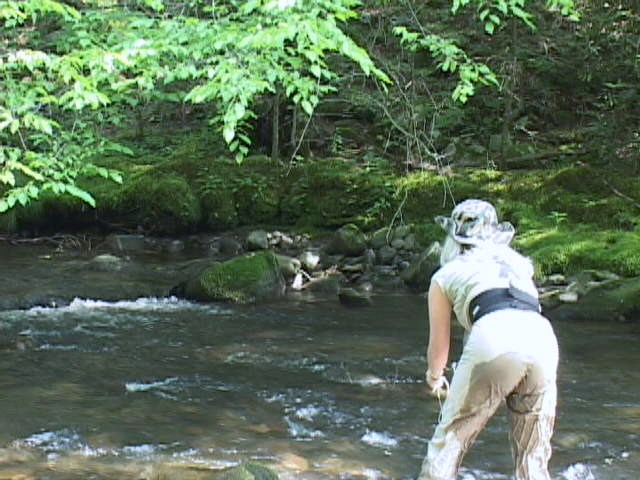
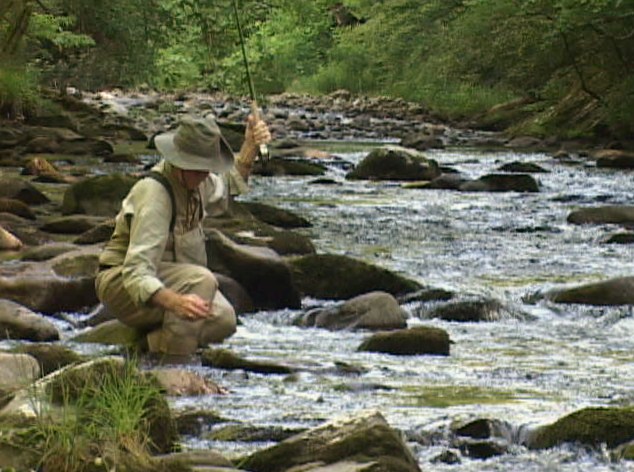
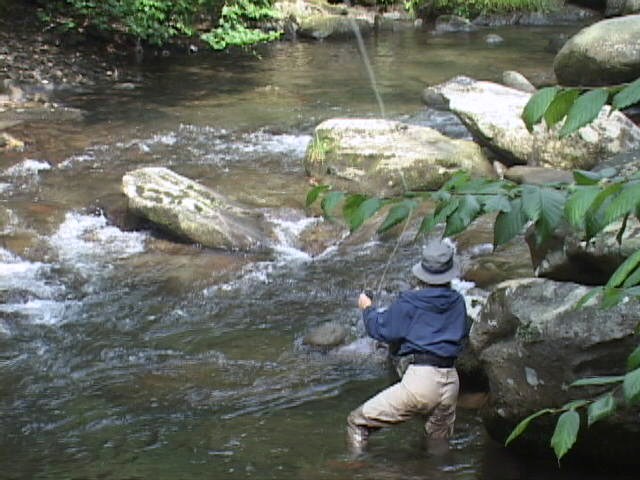
The Spring Season is considered the best time to fly fish the Smokies because it is usually the easiest time of the year to catch trout. Some days the trout will respond favorably even when you hit them over the head with the fly line. Some days, especially a day or so after a cold front has moved through and the water temperatures have fallen, the trout will seem to get lock jaw. Some anglers think they move to the bottom or in shallow sunny areas to get warm. They don’t. They just stop feeding as aggressively for a front you will just have to fish slower and probably swap to a nymph to catch many fish. After the passage of a cold front, the sudden change in water temperature has more effect than the actual water temperature itself.
Weather:
During the Spring things change and usually change fast. Weather can range from being extremely cold to very warm. The water temperatures respond by changing almost as fast as the weather. The first thing you need to do each day you fish is to check the water temperature. This will tell you a lot about both the trout and the aquatic insects they feed on. The warming water increases the activity of the trout and consequently, their need for more food.
Spring is also the time most of the aquatic insects hatch into adults. During the hatch they are more subject to being eaten by trout. We feel like this is natures way of providing the trout that needed food as well as it is in sustaining the existence of the insects themselves.
Water Levels:
The Smokies usually receive more rainfall during the spring months than any other time of the year. The changing water levels can drastically change the fishing conditions. Streams can go from normal flows to flooding conditions where the water is out of its normal banks and spread up into the woods. The rising water levels can end fishing at times and even become dangerous. Even when high water occurs, the streams return to their normal levels very quickly, usually within a day or two.
High water, not in a flooding condition isn’t all bad. In fact it can be good. For one thing, it stains the water enough that you are able to fool the trout easier. Food is washed in by the heavy rain and provides additional food for the trout near the banks. Although it may be too high to wade safely, you can usually find water to fish where you can cast from the banks.
Hatches:
The days will become longer during the spring and you will be able to fish latter than you did in the winter months. This is important because some of the hatching insects fall spent in the water after mating and/or after the females have deposited their eggs. Often the spinner falls are condensed into a short time and there is more of them on the water than anytime during the hatch.
To consistently catch trout during the Spring, anglers need to be able to adjust to the changing conditions of water temperatures and water levels as well as be prepared for a variety of hatches that will occur.
Midges:
Chironomidae midges will hatch all during the Spring and for the rest of the year for that matter. These tiny insects can be very important when the water temperature is in the low forties or high thirties and nothing else is hatching. Don’t overlook them or you may be one of those guys that go around declaring how bad the fishing is when it’s really not.
Blue-winged Olives:
At the beginning of Spring, Blue-winged Olives, primarily some of the Baetis species, will often hatch in good quantities on cloudy, overcast or rainy days. Hook sizes range from 18 to 24.
Little Blue-winged Olives:
Various species of the Little Blue-winged Olives of the Acentrella and Diphetor genera. Plauditus genera may also hatch. Sometimes these hatches overlap and sometimes more than one hatch is occurring at the same time. None of these hatches are very prolific. The little swimming nymphs are not as well suited in the pocket water of the Smokies as they are in many other types of water. The hatches are usually spaced out along a stream with no continuous populations. Hook sizes range from 20 to 26.
Little Black Winter Stoneflies:
Little Black Stoneflies, or Capniidae family stoneflies, sometimes called Snowflies, will already have hatched but may still be around in the early part of Spring, depending on the weather.
Black and Little Brown Stoneflies:
Little Black and Little Brown Stoneflies, both of the Taeniopterygidae family, may still be around during the first part of Spring depending on the particular species. Some will still be hatching. You may catch some trout feeding on the adults depositing their eggs but you are far better off imitating the nymphs crawling on the bottom to the banks and rocks to hatch.
Little Black Caddis:
Another one of the first hatches you will notice in the Spring is the small dark colored caddisfly. They look black but are actually a very dark brown. These are about a hook size 20. You will first notice them crawling around the rocks and boulders in the stream. These little caddis hatch when the water is between 45 and 50 degrees. The pupae is the main stage of life to imitate.
Little Black Caddis (Grannom):
Little Black Caddis, sometimes called the American Grannoms, or Brachycentrus species, will hatch when the water stays around 50 degrees for a few days. This is an overlooked hatch by many anglers. During this hatch it’s relatively easy to take trout on both the emerging pupae (first) and the egg layers (last) during the afternoon from noon until dark. You will usually see the little chimney cases attached to rocks swinging in the current before this hatch occurs.
Little Black Short-horned Sedges:
You will find some Little Black Short-horned Sedges or Glossosoma species, but we have never found them to be intense hatches. They are about a hook size 20 to 22. The emergers are the most important stage because they emerge in the stream like a mayfly and usually stay on the water until they get to the banks. They dive to deposit their eggs so a wet fly works best for the egg layers.
Tiny Black Caddis:
Species, called Tiny Black Caddis, are occasionally found in some of the park’s streams. They also hatch when the water reaches about 50 degrees. These are a hook size 20-22. These crawl out of the water to hatch during the day and deposit their eggs in the afternoons. Imitate the pupa, not the adult during the hatch.
Green Sedges:
The Green Sedges or Rhyacophila species also usually hatch in sparse numbers (except in Abrams Creek where they are plentiful) in the streams where they are found. Their free living larvae are known as Green Rock Worms. There are several species of them in the park. They range in hook size from 14 to 18 and live in the fast water and riffles. The larva stage is by far the most important stage to imitate.
Cinnamon (Spotted) Sedges (Abrams Creek):
In Abrams you will also find some of the net-spinning caddisflies that hatch in the Spring. These are mostly the Ceratopsyche species called Cinnamon Sedges. You also may find them in some other streams by they are usually less numbers of them.
Little Sister Caddis (Little Olive Sedge) (Abrams):
Cheumatopsyche or Little Sister Sedges also hatch in Abrams Creek. These are also net-spinning caddisflies. They can be found in some other streams but never in any appreciable concentration. If you find the rocks slick, you may find some of these and the other net spinners.
Blue Quills:
The Blue Quills, or Paraleptophlebia adoptive species, hatch in every stream we have fished (about all of them) when the water is about 48 degrees or warmer. This is a very prolific hatch that will stay around for at least a month or longer depending on the weather. This hatch is as important a hatch as they are in the park. These small mayflies are a hook size 18.
Quill Gordon:
The Quill Gordon, or the Epeorus pleuralis, will also hatch when the water stays around 50 degrees for a short time. This is an exciting hatch that many anglers consider the best of the mayfly hatches for the Smokies. They emerge between the bottom and surface of the water. Wet flies usually work better than the dun patterns but they will take the duns aggressively at times provided the water temperature is still on the rise. If a cold front slows the hatch, wets will outperform the dun imitations considerably. Work the areas behind large boulders or pockets. The nymphs will congregate there in the slower water until they hatch. Nymphs and/or wet flies will produce in these pockets. These mayflies are a hook size 12 to 14.
Hendricksons and Red Quills:
Hendricksons and the Red Quills, or the Ephemerella subvaria, will follow shortly thereafter. The Hendricksons are the females and the Red Quills are the males. The two are different sizes and colors. These hatches only occur in certain areas of certain streams. You can’t expect to find them everywhere. These are crawler nymphs and are better suited for moderate water. Fish both the emergence and the spinner falls. By the way, the spinners of both the males and females are different colors than the duns as well as each other. These are usually a 12 to 14 hook size.
Pale Evening Duns:
In some areas of a few streams you will find some Pale Evening Duns or Ephemerella species that used to be the rotunda and invaria species. Now the entomologist have declared they are the same species. It’s unimportant to anglers who for the most part incorrectly call them Sulphurs. Hooks size are 14 to 16.
Sulphurs:
Speaking of Sulphurs, or the Ephemerella dorothea – you will also find a few of them in certain places in some streams. They too are crawler nymphs and not well suited for much of the water in the park. They are a hook size 16.
American March Browns:
The American March Browns, or Maccaffertium vicarium species, will show up at the last part of Spring. These are large mayflies usually a hook size 10 to 12 but can get smaller as the season progresses. Mayflies of the later season hatches of this same species are called the Gray Fox by some anglers. This is the same mayfly but they can be darker and smaller in the later part of the hatch.
Perlodidae Stoneflies (Little Yellow Sallies):
Little Yellow Stoneflies (called Yellow Sallies) of the Perlodidae family, will appear sometimes at the end of April or the first of May. They can hatch prolifically. Different species of the Little Yellow Stoneflies can hatch sparsely throughout the summer and on into early Fall. The hook size will vary considerably depending on the species.
Eastern Blue-winged Olives:
During the last part of the spring season you may see some species of the Eastern Blue-winged olives, or Drunella species. These are larger mayflies from a 16 to and 18 hook size. The hatches are usually sparse.
Little Eastern Blue-winged Olives:
The Little Blue-winged olives, Attenella species, will also hatch in a few places. These mayflies are usually a hook size 18.
Eastern Green Drakes:
Don’t forget that the huge Eastern Green Drakes, Ephemera guttulata, start hatching during the month of May in Abrams Creek. Fishing should be good during the days while they hatch slowly throughout the day but you will miss the most important part of the hatch, or the spinner fall, unless you stay in the Cades Cove area until after it is closed. These large mayflies range in hook sizes from a 6 to a 10.
Giant Stoneflies:
The Giant Stoneflies, or the Pteronarcys dorsata, will hatch later in the Spring and when you first see some of the large shucks, it means it is time you should try fishing a large stonefly nymph. This is a hit or miss situation because the night time hatch is spread out over a long period of time and is never very intense. These range in hook sizes from a 6 to 10 depending on the age of the nymph. The adults are usually a hook size 6 or 8.
Slate Drakes:
Before the spring season is over you may even see the first of the Slate Drakes or Isonychia bicolor mayflies. These big mayflies hatch out of the water and the only stages that are important are the nymph and spinners. These vary in hook size from a 10 to 14. This is the first part of a long, extended weird hatch. After this, it will be sparse and then increase again in the Fall.
Light Cahills:
You may even see a few Light Cahills, or Stenacron interpunctatum, start showing up in May. They hatch throughout the day in small numbers. The spinner fall can be more important than the emerging duns since it’s more concentrated. These are clinger nymphs that stay hidden down in the rocks until the hatch except at times they feed and molt. Hook sizes are a 12 to 14.
Cream Cahills:
Near the first of June, you may even see a few other Maccaffertium species of Cream Cahills. These are very similar to the Light Cahills but are usually a lighter color. They are clingers and the nymphs are mainly important only during the hatch. These range in hook sizes from a 12 to a 16.
Little Green Stoneflies:
The Little Green Stoneflies, or Chloroperlidae family species, may start hatching before Spring ends. Look for them in moderate to slow moving water. We have not found them in any large quantities.
Streamers/Buggers/Sculpin Imitations:
Don’t forget streamers and Wooly Buggers. They are at their best during the Spring. They work best when the water is slightly stained or even well stained depending on the color you choose. They are also very effective when the water is high, even running out of the banks of the stream. They will work better early or late in the day if the water is very clear. This is the best way to catch a big brown trout. They didn’t get big eating insects in the Smokies. Crawfish, sculpins and baitfish made them large.
Summary:
As you can see, that is a lot of different hatches. There are at least a dozen more caddisfly hatches that occur in certain streams in the park but none of them that we have discovered are very prolific or important. There are not but a very few hatches of any aquatic insects capable of causing the trout to feed selectively. Most of them hatch far too sparse to cause the trout to key in only on that one insect. On the other hand, some of them, mainly the Little Yellow Stoneflies, Little Black Caddisflies, Blue Quills, and Quill Gordons can cause selective feeding. Even then, it only occurs in certain areas in a stream where the hatch is intense and last for a few days. When that happens you may find the trout not paying any attention to your generic or attractor flies. You may need a more specific imitation. We prefer to use a specific imitation of something we know is hatching anytime in preference to a generic imitation.
If multiple hatches are occurring, we would change flies to something else we know is hatching or another stage of the insect we first tried and experiment using the trial and error method.
If nothing is hatching, and you want to catch fish, we recommend that you change to a specific imitation of the nymph or larva stage of something you know is in the water that is approaching its normal hatch period. For example, if the Blue Quills or Quill Gordons haven’t hatched yet and the water temperature is in the range of 45-48 degrees and rising, fish a imitation of the small Blue Quill nymphs (slim crawler nymphs) in the calmer water edges near fast water or fish a larger specific imitation of the two tailed Quill Gordon nymph (flat clinger nymph) behind the big boulders and rocks out in the stream where the nymphs tend to congregate prior to hatching.
Copyright 2011 James Marsh
